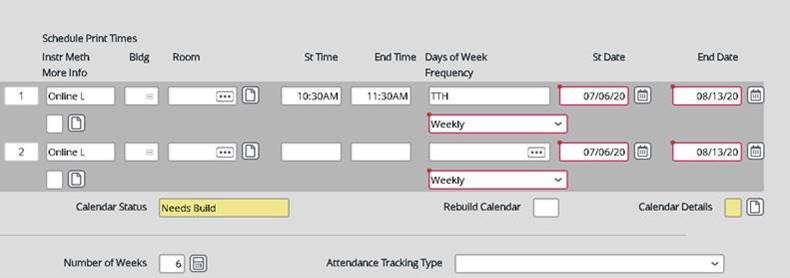
Resources for Deans
The online and digital education resources on this page are for deans, administrative assistants, and other campus leadership.
Resources
The Department of Online and Digital Education at El Camino College is here to support you and your faculty and staff in the following areas:
- Canvas Learning Management System (LMS) course site creation and maintenance.
- Training and certifying faculty for teaching online and hybrid courses.
- Support for online and hybrid curriculum proposals and course development.
- The online administration of course evaluations.
- Supporting accessibility of content in Canvas.
- Answering questions and offering support related to El Camino's participation in the California Virtual Campus-Online Education Initiative.
The Department of Online and Digital Education cannot offer direct support with the Student Information System except as it related directly to the Canvas LMS. Technical support needs outside of Canvas should be directed to the Technical Services Help Desk. Please contact the Special Resource Center for questions around student accommodations.
If you have questions or require clarification about any of the material presented here, please contact Dr. Moses Wolfenstein.
If you have faculty who you want to teach online, they need to be certified to do so at El Camino. There are two paths for certifying faculty who are not already cleared to teach online here:
- Successful completion of the LOGIC (Learning Online and General Instruction in Canvas) and passing the final course walkthrough.
- Approval through the Distance Education Waiver process.
Distance Education Certification is up for certification maintenance. Certification maintenance processes (approved by Academic Senate June 1, 2021 and detailed in AP 4105) are listed below:
- The department of Online and Digital Education (ODE) will notify faculty who are required to complete DE maintenance or recertification. The communication will request confirmation that the faculty intends to maintain their DE certification and will ask the faculty to indicate which option they will choose to maintain their certification and submit the materials as directed:
- Submit 10 hours of distance education-related professional development that has occurred over the five (5) years since the faculty was certified or last maintained their certification. Proof of hours will be pulled from Cornerstone, so faculty do not need to submit it if they have already submitted it in Cornerstone.
Types of professional development can include:
- Professional development opportunities listed in Cornerstone and notated as Distance Education
- Professional development opportunities provided by @One or CCCTech
- Participation at distance education-related conferences
- Participation in other types of activities as described in the El Camino College Flexible Calendar Program Professional Development Categories and Approved Flex Credit Activities
- document that is focused on contemporary Distance Education practices
- Engage in a course quality improvement process (e.g., POCR) which will be tracked by Online & Digital Education and result in updating faculty status in the certification database.
- Participate in recertification refresher course that will update faculty on new requirements, regulations, tools, and best practices.
The faculty materials will be reviewed for completeness. If the submission is complete the faculty will be notified that they have been recertified and will be provided with their next recertification date. If a faculty member has not taught in a distance education format within the previous three (3) years, they are required to take an accelerated renewal course to be recertified.
Scheduling Online Classes
This procedure outlines the process for assigning Distance Education classes and ensuring that assigned faculty are Distance Education Certified.
- Faculty wishing to teach online will complete the Distance Education (DE) certification process, either through the Academic Senate approved certification course offered by the Distance Education Faculty Coordinator or through the waiver process as described in Administrative Procedure 4105 - Distance Education (AP 4105).
- Certification must be completed by:
- July 30th to teach DE the following fall
- October 31st to teach DE the following winter
- The last day of the fall semester to teach DE the following spring
- April 30th to teach DE the following summer
The Online and Digital Education Department (ODE) will maintain the records for faculty certified to teach in Distance Education formats (see AP 4105) and make the list accessible to the Division offices.Division offices will ensure that all faculty being assigned to a Distance Education format are certified by using the list described in number 3 above. ODE will pull lists of all faculty members assigned to courses in DE formats from Colleague at least one month prior to the end of the previous term to audit. If Division offices have questions about new faculty members or faculty members who might be in the process of completing their DE certification, administrators will contact the Distance Education Faculty Coordinator to confirm that the faculty member will be eligible to teach courses in DE formats prior to the start of the term. Online and Digital Education will audit the course assignments for Distance Education classes and report findings to the Vice President of Academic Affairs (VPAA) office. In the event the audit shows that there are faculty course assignments out of compliance with the certification requirements, the VPAA office will coordinate between any Divisions out of compliance and ODE to rectify course assignments and ensure adherence to policy and procedure.In the event of late assignments due to added sections or changes in faculty availability, Division offices will check with ODE prior to assigning the new or replacement instructor unless that faculty member is already assigned to another DE course in the same term.
Academic Senate Approved March 1, 2022.
- Placing Substitute Faculty in a Canvas Course form
- AP 4105: The administrative procedure governing distance education at El Camino. This AP is currently in the revision process in order to update it and align it with changes in state policy language.
- Guidelines for Course Observers: This guide aides observers when doing course site observations in conjunction with Faculty Evaluations.
This should look familiar if you have built Hybrid classes before.
After pulling up the section in SOFF, you go down to the “Schedule Print Times” portion, and you can add an additional entry, where you identify the Instructional Method as “Online Lecture”. You fill in the days and times and leave the location blank. This is exactly the same thing we do for hybrid courses, just without a Building and Room.

It’s also possible to delete the original non-scheduled hours there, but that could give the impression there was no additional asynchronous content.
This leads to the course looking this way in the searchable schedule:

ITS is looking into masking the location information there so that the TBAs don’t cause confusion.
- The FinishFaster Search Tool: You can look up the courses El Camino and other partner California Community Colleges offer online on the CVC-OEI home page.
- The CVC-OEI Ecosystem: A link to the different tools provided by the state.
- The OEI Course Design Rubric: We use this rubric here at El Camino as a tool for guiding and evaluating course development so as to maintain the best possible alignment with state standards. This rubric is used by state reviewers to certify courses for the quality badge in the FinishFaster course search tool.